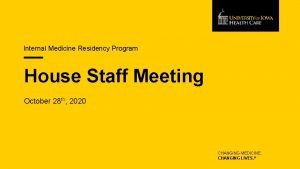A New Research Curriculum for Family Medicine Residents

- Slides: 1

A New Research Curriculum for Family Medicine Residents Adrienne A. Williams, Ph. D and Shana O. Ntiri, MD, MPH Department of Family & Community Medicine, University of Maryland School of Medicine Introduction Blackboard Online Curriculum Rotation Evaluation ACGME requires that residency curriculum includes a research education component. Many Family Medicine residencies struggle in the development and implementation of a research curriculum. Other Residency Scholarly Activities Intern Introduction to Research (PGY 1) Journal Club (PGY 2) Resident Research/Quality Improvement Project (PGY 3 ) Educational Conferences (CORE) (All) University of Maryland’s Department of Family & Community Medicine recently developed a new two week, web-based research curriculum that is easily adaptable at both academic and community-based residencies, regardless of size. Implementing Research Curriculum at Your Residency Identify Core Faculty • Faculty champion/additional faculty Identify Residency Resources • Library/IRB/Research faculty Designate a time in your residency curriculum This poster will provide full details of this new curriculum and resources needed to implement this training. • Residency year • 2 weeks/4 weeks/longitudinal Determine Curriculum Format • Paper/Email/Web-based Curriculum Overview Module I: Research Methods and Data Analysis • Introductory articles on the basic principles of clinical research Module II: Article Review • Application of principles learned in Module III: Research Relevant Board Review • ABFM style questions on statistics/epidemiologic concepts Module IV: Literature Search • Guidance on how to conduct a literature search Module V: Literature Review and Proposal • Application of all the rotation modules to develop a research proposal RESEARCH POSTER PRESENTATION DESIGN © 2011 www. Poster. Presentations. com Sample Resident Research Project Department of Family & Community Medicine References • Articles for Module I: Background Reading • Oxman, A. D. , Sackett, D. L. , & Guyatt, G. H. (1993). Users' guides to the medical literature. I. how to get started. the evidencebased medicine working group. JAMA : The Journal of the American Medical Association, 270(17), 2093 -2095. • Guyatt, G. H. , Sackett, D. L. , & Cook, D. J. (1993). Users' guides to the medical literature. II. how to use an article about therapy or prevention. A. are the results of the study valid? evidence-based medicine working group. JAMA : The Journal of the American Medical Association, 270(21), 2598 -2601. • Guyatt, G. H. , Sackett, D. L. , & Cook, D. J. (1994). Users' guides to the medical literature. II. how to use an article about therapy or prevention. B. what were the results and will they help me in caring for my patients? evidence-based medicine working group. JAMA : The Journal of the American Medical Association, 271(1), 59 -63. • Jaeschke, R. , Guyatt, G. , & Sackett, D. L. (1994). Users' guides to the medical literature. III. how to use an article about a diagnostic test. A. are the results of the study valid? evidence-based medicine working group. JAMA : The Journal of the American Medical Association, 271(5), 389 -391. • Jaeschke, R. , Guyatt, G. H. , & Sackett, D. L. (1994). Users' guides to the medical literature. III. how to use an article about a diagnostic test. B. what are the results and will they help me in caring for my patients? the evidence-based medicine working group. JAMA : The Journal of the American Medical Association, 271(9), 703 -707. • Laupacis, A. , Wells, G. , Richardson, W. S. , & Tugwell, P. (1994). Users' guides to the medical literature. V. how to use an article about prognosis. evidence-based medicine working group. JAMA : The Journal of the American Medical Association, 272(3), 234237. • Bem, D. J. (2004). Writing the empirical journal article. In J. M. [. Darley, M. P. [. Zanna & H. L. I. [. Roediger (Eds. ), The compleat academic: A career guide (2 nd ed. ) (pp. 185 -219). Washington, DC, US: American Psychological Association; US. Retrieved from http: //proxyhs. researchport. umd. edu/login? url=http: //ovidsp. ovid. com/ovidweb. cgi? T=JS&CSC=Y&NEWS=N&PAGE=fulltext&D=ps yc 4&AN=2003 -06256 -010 • Bewick, V. , Cheek, L. , & Ball, J. (2004). Statistics review 13: Receiver operating characteristic curves. Critical Care (London, England), 8(6), 508 -512. doi: 10. 1186/cc 3000 • Articles for Module II: Article Review • Lynn, R. (2000). Race differences in sexual behavior and their demographic implications. Population and Environment: A Journal of Interdisciplinary Studies, 22(1), 73 -81. doi: http: //dx. doi. org/10. 1023/A: 1006633632359 • Mac. Mahon, B. , Yen, S. , Trichopoulos, D. , Warren, K. , & Nardi, G. (1981). Coffee and cancer of the pancreas. The New England Journal of Medicine, 304(11), 630 -633. doi: 10. 1056/NEJM 198103123041102. • Kulasingam, S. L. , Hughes, J. P. , Kiviat, N. B. , Mao, C. , Weiss, N. S. , Kuypers, J. M. , et al. (2002). Evaluation of human papillomavirus testing in primary screening for cervical abnormalities: Comparison of sensitivity, specificity, and frequency of referral. JAMA : The Journal of the American Medical Association, 288(14), 1749 -1757. • Ferreira, F. L. , Bota, D. P. , Bross, A. , Melot, C. , & Vincent, J. L. (2001). Serial evaluation of the SOFA score to predict outcome in crtically ill patients. JAMA : The Journal of the American Medical Association, 286(14), 1754 -1758.

